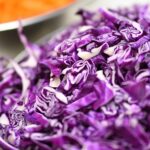
Simple, crunchy, and delicious – Krautsalat, or German coleslaw, is a time-honored side dish that plays a starring role in German cuisine. Unlike American-style coleslaw, which often uses mayonnaise, Krautsalat is vinegar-based, with a lighter and tangier flavor. It’s a staple at beer gardens, BBQs, and Sunday family meals.
This classic salad is a perfect example of German culinary practicality – using fresh cabbage, a bit of acid, and a few pantry staples to create something both refreshing and deeply flavorful.
The Origins of Krautsalat Recipe
Cabbage is one of the most iconic vegetables in German cooking. It stores well through the winter months and has been used for centuries in dishes ranging from fermented sauerkraut to braised red cabbage. Krautsalat, served raw and marinated, is especially beloved in southern Germany, including Bavaria and Swabia.
This coleslaw-style salad likely originated as a way to preserve fresh cabbage and enjoy it with hearty meals. It’s still commonly found as a side dish to meats, sausages, and fried fare. You’ll see it at Oktoberfest tables, rural weddings, and home kitchens alike.
To explore more classic cabbage-based recipes, visit our German Salad Recipes collection.
Ingredients for Authentic Krautsalat Recipe
- 1 small white cabbage (about 800 g), finely shredded
- 1 small onion, thinly sliced
- 4 tablespoons white wine vinegar or apple cider vinegar
- 3 tablespoons neutral oil (sunflower or canola)
- 1 teaspoon sugar
- 1 teaspoon salt
- Freshly ground black pepper to taste
- Optional: 1/2 teaspoon caraway seeds
- Optional: 1–2 slices of bacon (for the warm version)
Tools You’ll Need:
- Large mixing bowl
- Mandoline or sharp knife
- Small saucepan (if using warm dressing or bacon)
- Wooden spoon or salad tongs
How to Make Krautsalat (Step-by-Step Instructions)
Step 1: Shred the Cabbage
Cut the cabbage into quarters, remove the core, and finely shred the leaves. Place the cabbage in a large bowl and sprinkle with salt. Let it sit for 10 to 15 minutes to soften slightly.
Step 2: Massage the Cabbage
Using your hands, firmly massage the cabbage until it begins to wilt and release its juices. This step is key to breaking down the raw texture and helping it absorb the dressing.
Step 3: Prepare the Dressing
In a small bowl, whisk together the vinegar, sugar, oil, and pepper. If using caraway seeds, add them now.
Step 4 (Optional): Bacon Version
For a heartier version, dice bacon and fry in a pan until crispy. Add the hot bacon and some of its rendered fat to the cabbage just before dressing. This adds richness and is especially popular in Bavarian recipes.
Step 5: Combine and Chill
Add the thinly sliced onion to the cabbage. Pour the dressing over and mix thoroughly. Let the salad sit for at least 30 minutes before serving, or chill for several hours for deeper flavor.
How to Serve Krautsalat
Krautsalat is a natural pairing for grilled meats, schnitzels, or traditional sausages like Bratwurst. It also complements potato-based dishes such as Kartoffelpuffer (Potato Pancakes) and Kartoffelsalat.
It’s often found as part of a “mixed salad plate” alongside Gurkensalat (Cucumber Salad) and Rote-Bete-Salat (Beetroot Salad), especially in Swabian or Bavarian restaurants.
For a festive table, serve it with Schweinebraten (Pork Roast) or Leberkäse.
Variations and Regional Twists
Warm Dressing:
Some traditional recipes use a warm dressing made by heating the vinegar, sugar, and oil together before pouring it over the cabbage.
With Carrots:
Grated carrots are a common addition for color and sweetness.
Spicy Touch:
A pinch of paprika or a splash of mustard can give the dressing a bit more complexity.
Swabian-Style:
Swabian Krautsalat is typically more acidic and includes caraway seeds. It may also be dressed while the cabbage is still warm for better absorption.
No Onion Version:
Some regions prefer Krautsalat without onion, especially if it’s served with onion-heavy main dishes.
Looking to explore more regional flavors? Our German Salad Recipes page features everything from sausage salads to marinated mushrooms.
Krautsalat is a crunchy, tangy celebration of cabbage – one of Germany’s most treasured vegetables. It’s easy to make, endlessly adaptable, and perfect for pairing with rich or fried foods.
Whether you prepare it for a backyard BBQ, a traditional Bavarian dinner, or a weekday lunch, it brings fresh texture and bright flavor to any table.
For more iconic German salads, try Rotkohlsalat (Red Cabbage Salad), Schwäbischer Kartoffelsalat, or browse the complete collection at German Salad Recipes.







